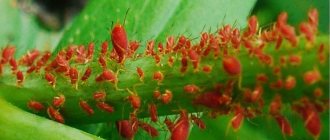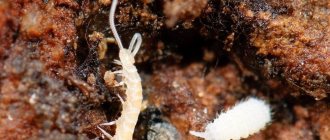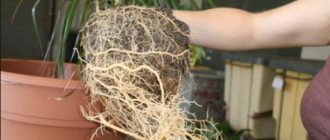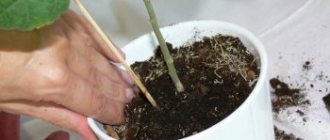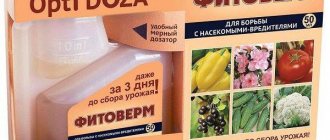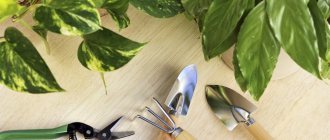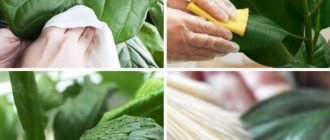Houseplants are no less susceptible to insect attacks than garden plants. Improper care of flowers contributes to the appearance of flying, jumping and crawling pests. Most of them are very dangerous for plants - they damage the root system, suck juice from leaves and stems, bite through buds, preventing flowers from blooming. A common occurrence is small white worms in the soil of indoor plants.
Types of insect pests similar to worms
White or transparent worms in indoor pots are a warning sign. Pests weaken the plant and slow down its growth. The flower stops producing buds, the leaves turn yellow and wither. These worms can be either adult insects or their larvae. Whatever they are, if timely measures are not taken, the plant may die.
When we talk about larvae, we usually mean several genera of insects from the order Diptera.
Springtails (springtails, springtails) are tiny arthropods no larger than 5 mm in size. They have a jumping fork in the lower part of their body, which allows them to move quickly. Some specimens are so small that they are difficult to see. Often, owners notice white worms in the tray, in the water remaining after watering. Insects live in the soil and feed on organic debris. If this nutrition is not enough for them, the roots of the flower and young shoots are destroyed. Waterlogged soil is a favorable habitat.
Representatives of the Sciarich family that indoor gardeners encounter:
- sciara midges;
- fungus gnats;
- genus Bradysia.
Only a specialist can find the differences between these insects, but the damage they cause and the methods of control are almost the same. The insect is a small mosquito. The length of the thin body is 3-4 mm, the head is round. It has only a front pair of transparent wings, and in place of the hind wings there are club-shaped halteres.
Insects fly well and reproduce quickly. A young mosquito has a light gray body, which turns black with age. Adults do not cause any particular harm to plants, but can carry various diseases and the larvae of other pests.
The main damage is caused by fungus gnat larvae - white, transparent worms 3-5 mm long with a black head.
Insects damage the root system of indoor flowers. The supply of nutrients and moisture to the plant is disrupted, and the flower may die. The larvae get in with the contaminated soil. The second way for adults to enter an apartment is from the street through open windows. Mosquitoes prefer waterlogged soil.
Nematodes (roundworms) are protostomes. Zoologists suggest the existence of about a million species on earth. They live in fresh and salt water bodies, in the soil.
Nematodes are tiny worms in indoor flowers that grow in moist soil and feed on living and dead plants.
Types of plant nematodes:
- Galls that settle on the roots, their secretions contribute to the formation of thickenings in which pests live and reproduce. When the eggs mature, the shell is destroyed and the larvae spread in the soil.
- Nematodes with free formation of cysts are attached to the root.
- Free nematodes do not have a permanent place of residence, crawling and damaging various plant organs.
Signs of nematode damage:
- the appearance of yellow and subsequently brown and black spots on the foliage;
- reduction in leaf size, their deformation;
- curvature of stems, drying of apical buds;
- the formation of thickenings and swellings on the root system.
Nematodes lay oval eggs, from which white, partially transparent larvae emerge.
The appearance of enchytrea in house flowers is difficult to notice; they live on the roots of plants. If measures are not taken, the root system will be covered in worms. Signs of damage are stunted growth, yellowing of leaves. Enchitraea often appear in greenhouses; they love warmth and moisture. Pests look like small, mobile white worms with pointed ends. The body of the worm is translucent, through which the digestive organs are visible. These pests are good food for aquarium fish.
Sulfur from matches
Sulfur is part of complex fertilizers. In addition, fungicides based on this microelement are used for treatment at the first signs of a fungal disease.
To rid indoor flowers of pests, experienced flower growers stick matches into the ground with their heads down. After some time, the midges and their larvae will disappear, and the plant will receive almost free feeding.
The disadvantages of this method include the need to frequently change matches: the sulfur on them dissolves in one day. Wooden sticks left in the soil can rot and cause pathogenic flora to multiply.
Fighting methods
If there are pests in a flower pot, you need to get rid of them urgently. Depending on the degree of damage, choose control methods.
Since white worms live mainly in the soil, mechanical removal is ineffective. You can remove or wash off the adult specimens from the roots, but you will not be able to get rid of the eggs and larvae. If pests have just appeared, replant the indoor plant in healthy, calcined soil. Treat the soil with insecticides. When replanting, remove adult insects, larvae and eggs from the root system. Trim damaged areas and treat with disinfectant solutions.
In a specialized store you will be offered several proven drugs for controlling soil pests:
Chemicals are toxic; safety rules must be strictly followed.
If you are not a supporter of chemical reagents, try folk remedies:
- Prepare a pale pink solution of potassium permanganate and water the indoor plant several times with this solution.
- Use a soap solution for spraying.
- Place citrus peels, garlic cloves near the flowers, and treat the soil with anise oil.
- Prepare a solution of 5 g of tobacco dust and a liter of water. After steeping for 24 hours, spray the plant and soil in the pot. Repeat the procedure once a week for 1-1.5 months.
Many gardeners are convinced that matches stuck with sulfur heads into the soil help deal with white worms in the soil.
Insecticide
The most effective way to combat any harmful insects is the use of professional insecticides. Good results in pest control can be achieved with drugs containing imidacloprid or thiamethoxam. These substances are synthetic analogs of nicotine.
Based on them, many pest control products have been created. When sprayed, the drug penetrates the above-ground parts of the plant and remains there for a long time.
The substance itself does not harm plants, but kills insects that land on them. Worms and larvae living in the soil also die.
Like the use of any chemical pesticides, the use of such products can negatively affect the health of people and animals. Bio Spark is considered the safest drug containing a small dose of imidacloprid. When working with it, you must wear gloves and a respirator, and then thoroughly ventilate the room.
Prevention measures
It is easier to prevent insects from infecting plants than to fight them.
Listen to the advice of experts:
- Even if you notice one fly or worm, check all the pots.
- Replace the soil, wash the containers.
- Adjust watering, do not over-moisten the soil.
- Do not use folk remedies for fertilizer - tea leaves, meat juice. These products create favorable conditions for the proliferation of pests.
- Do not place vases with purchased flowers near indoor plants.
Monitor newly acquired plants and soil. Follow the rules of flower care; a healthy plant is less susceptible to pests.
Folk remedies for midges in flowers
Midges have appeared in flowers - the problem arises of what means to use to rid your favorite plants of them without harm. One of the ways to independently remove irritable insects is to use various folk remedies.
An effective folk remedy against flies is garlic . The smell of garlic has a detrimental effect on some insects, including flower midges. Just two procedures - and black midges completely die. To prepare the required solution, take three heads of garlic and chop them using a garlic press. The resulting mass is poured with one liter of boiled water. After 4 hours, strain. The leaves of the plants are sprayed with this solution and the soil in the pot is treated.
If soil flies are detected, a solution of potassium permanganate . The soil in the pot is being cultivated. It is recommended to repeat watering the damaged flower after 2 days. In order not to harm the roots of the plant, the solution should be weak.
You can kill flower flies in the soil of a houseplant using soap . To do this, you need to grate laundry soap (20g) and fill it with 1 liter of water. The resulting soap solution is used to treat the leaves and water the soil in the pot.
You can also get rid of flower midges using regular matches . In a pot with a flower, you should deepen about five matches of sulfur into the soil and lightly water the soil. Matches in flowers are replaced every day, as sulfur dissolves in the soil. A certain number of such procedures will rid the plant of both midges and their larvae.
Wood ash is an equally effective folk remedy in the fight against insects on indoor flowers. The soil in the pot is simply covered with such ash and the midges will forever leave the flower they have chosen alone. Plus, wood ash is considered an excellent fertilizer that gives the plant strength.
tobacco helps fight bugs . To prepare the tincture, take 50g of dried tobacco and add one liter of water. Infuses for 2 days. The resulting tincture is sprayed onto the leaves of the flower. The disadvantage is that tobacco tincture has a detrimental effect only on adult insects; the larvae do not die from it.
Ground flies do not like the smell of mint . The edge of the pot can be smeared with the well-known “Star”. This will help get rid of harmful insects.
Celandine tincture (100g of celandine per 1 liter of boiled water) also gets rid of annoying bugs. Treated by spraying plant leaves.
You can also destroy insects in house plants using ammonia . In addition, it improves plant growth. The solution can be prepared by taking 50 ml of ammonia and diluting it in 4 liters of water.
Orange peels also help get rid of harmful insects that attack indoor flowers. The citrus smell irritates them. It is recommended to cover the flower pot with such crusts or to deepen them directly into the soil. The pests will blow away like the wind.
Or you can simply dry the soil . Also an excellent way to combat flower midges. Until the soil is completely dry, it is not advisable to water your “green friend”. Then cover the top of the soil with fried sand and sprinkle it with weak potassium permanganate.
Treatment of infected plants with folk remedies is considered the safest method compared to the use of chemicals.
Causes of plant infection
It often happens that lush greenery growing on the windowsill begins to wither and die. Having discovered an infestation of pests, the distressed housewife searches for the cause and cannot understand where the insects came from.
- The plants were taken outside, to an open veranda or balcony in the warm season.
- Windows or vents were left open for a long time. Theoretically, parasites can enter the house even through a small gap.
- The flower was transplanted into fresh substrate. Even store-bought soil can be contaminated, especially since there is no guarantee of protection if the soil is taken from a forest or garden.
- We bought an infected copy. Unfortunately, infestations are not uncommon in nurseries. They supply such products to stores.
- We made mistakes in daily care. They weaken the living organism, reduce its resistance, which parasites will certainly take advantage of.
Thus, there are quite a few ways for infection. It will not be possible to provide protection from everyone, so you need to prepare to fight for your green pets.
What to do if there are white worms in an indoor flower? :
One day, not yet knowing what to do with them - there were small white, motionless, apparently larvae and nimble little adults - I pulled the flower out of the ground, transplanted it into another, and simply took this one with the worms outside into the cold and specially checked it later. There was no one there anymore, and I used this soil later or not, I don’t remember. Now it’s the same story with another flower, but I just replanted it, so what, should I replant it again?
Three times in the winter I replanted the balsam (wet vanya) and washed it in manganese and still it appeared again, although the ground was frozen.
They say that soaking doesn’t help, you just need heat treatment, steam or something else.
I baked all the soil in the oven, and it didn’t do anything. Mom suggested a recipe for iodine + milk + water, maybe it will help.
Where do pests of indoor plants come from and how to find out about the appearance
- Insects that fly enter through open windows and vents.
- With a purchased plant from an infected nursery.
- Bringing home with forest or garden soil. Insects can also be found in purchased soil.
- An unexpectedly appeared pest, first of all, attacks a weakened plant that has not been properly cared for.
To recognize the pest, you should pay attention to the appearance of the green pet.
If white spots appear and the leaves are covered in places like cotton balls, a mealybug or brown bug has settled here.
The whitefly leaves a sticky substance on the leaves, after which they fall off.
The appearance of a whitish mesh indicates that a red mite has settled, and a cobweb indicates a spider mite. They also leave dusty marks on the bottom of the leaves, which causes curling. If there are a lot of spiders, the leaves dry out.
Yellow sticky spots signal an attack by scale insects or enchytrea worms.
Spots of brown and brown color on the bottom of the leaves with white streaks at the top - thrips have appeared.
When aphids and cyclamen mites appear, the green parts of the plant become deformed and dry out. In addition, the aphids leave behind a sticky residue.
If the leaves and shoots droop, a family of fungus gnats and leaf or root-knot nematodes feed on the sap.
Some pests of indoor plants live in the soil, eat roots, and cause damage to stems and leaves: root scale insects, enchytraea, root-knot nematode larvae, fungus gnats and white duras.
Other insects settle on the green parts: mealybugs, whiteflies, mites, scale insects, thrips and a colony of aphids.
What do sciarids look like?
This midge has many names; in addition to the fungus gnat, it is also called the tomato midge and soil midge. The adult insect is up to 4 mm long and has wings. The larvae are whitish, translucent, and have a black head. It’s easy to detect them; if you knock on the pot, midges will fly out, and if you stir up the top layer of soil, you will see white worms and even piles of skins from the molting of adult fungus gnats near the roots of the flower.
Sciarids end up in a flower pot with purchased soil or a purchased flower. Typically, midges live in waterlogged soil, but if you do not remove them immediately, but only reduce watering, they will not disappear, but will quickly get used to the new conditions and will reproduce well in a dry substrate.
Characteristics of indoor plant pests
Spider mites literally one millimeter in size are not immediately visible, but they are frequent guests on plants in the room. Dangerous parasites settle on the underside of leaves. Ticks love the juicy leaves of domestic citruses and roses, ficus and geraniums, hibiscus, palm trees, aspidistra and other plants.
Ticks do not settle where it is light and humid; insects prefer dry and hot rooms. Here the parasite flies on cobwebs to other plantings and leaves numerous offspring that suck the juices from the plants.
It is difficult to fight; some spider mites hide in the ground and attack if the flower weakens.
A colony of greenhouse, peach or nymphal aphids rarely appears on plants. Gray and green insects, 2 mm in size, visible. Aphids of the 1st and 2nd generations - without wings, slowly crawling insects. Thick translucent bodies of aphids on thin and long legs, antennae on the head.
Reproduction is rapid: the female lays 150 eggs. After a week, the hatched larvae grow into adult insects and reproduce. They live both on the plant and in the soil. The aphid has a sharp proboscis, with which it pierces the green parts of the plant, leaving white spots, and sucks the juice.
The third generation is born with wings and flies to neighboring plants, carrying the infection.
Scale insects are common and dangerous pests that pretend to be growths on the plant. four-millimeter insects with a dense light and dark brown chitinous shell. False scales are without a shell, females, without legs and without wings, and have a scute on top.
The body of scale insects is flat oval, the lower part is pressed against the green pulp. There are many varieties, the names indicate the insects' preference for choosing a plant.
Some representatives hide in the ground, laying eggs there. After 7 days the larvae emerge. Interestingly, some are already pregnant and do not need to mate.
Thrips do not like thick, dense leaves, but choose plants that bloom beautifully and feast on pollen. They do not refuse to suck the juice from young leaves. The punctures are marked with yellow spots and black excrement.
Poduras are small, white insects that jump on the ground. The body is elongated with sparse hairs and antennae on the head. There is little harm to green plantings. If there are a lot of insects, then a problem is created for gardeners.
Podura often feeds on plant debris and does not refuse to gnaw on live roots, which affects the growth of the plant.
The mealybug, or hairy louse, is considered a dangerous pest, most often attacking indoor plants. The body of 5 mm white worms is covered with a white or cream coating. They live in a colony.
Where the scale insects move, honeydew remains, which causes an infectious plant disease - sooty fungus. Females prepare nests for laying, similar to balls of cotton wool, for which they select leaf axils.
Whiteflies are also classified as dangerous pests. These are 3 mm flying moths with a yellowish tint. A powdery coating is visible on the wings, which makes them similar to moths. Pests feed on the sap of the plant, for which they pierce the leaf with a sharp proboscis.
A sticky honeydew remains where the whiteflies reside. After the greenhouse whitefly, numerous offspring appear on indoor plants in a short time. Insects often settle on fuchsias and ferns, geraniums, chlorophytum and dracaena.
Sciarids, or fungus gnats, similar to midges, are also called flower flies. 4 mm midges live in the soil of a flower pot, inhabiting the moist top layer, where they lay eggs. Crawling out, they fly around the room, annoying people, but do no harm to plants.
Small larval worms are difficult to notice; moreover, they live in the soil, where they eat the roots of the flower.
Rare guests on indoor flowers are nematodes, often gall nematodes. These are small, 1-1.5 mm, transparent worms, similar to a thread. There are no legs, and there are no segments in the soft body either. The mouth is like a piercing spear, which the nematode uses to pierce parts of the plant.
Females are fertile: they lay 1 thousand eggs in 1 month. Insects are able to freeze in development for 10 years, waiting for favorable conditions.
In addition, plants are harmed by:
- earthworms, if they accidentally got into the pot with soil;
- crawling earwigs;
- centipedes that eat roots, but also benefit by eating flies.
If you destroy pests in time, the insects will not suck the juice and your favorite plants will not die. The unhealthy appearance of the flower will tell you who has settled there, then it is easier to find a means of dealing with the unwanted guest.
Good afternoon I'm asking for advice on this issue: I recently bought a Genoa lemon and transferred it to another pot. The soil was forest soil, and I added a little “citrus” soil from the store. And then I discovered some kind of thin and long worm. Reddish in color. Diameter about 1mm. He crawled straight along the ground from above. Do we need to fight these worms? Or are they beneficial worms? Please tell me!
Any worms in pots are not useful. It is necessary to fight.
What is the best way to deal with worms? Water with potassium permanganate?
Watering it with Aktara helps against any living creatures.
Any worms in pots are not useful. It is necessary to fight.
- Chief administrators
- 5,740 messages
- My name is Olga
- Floor:
- City: St. Petersburg
- Collection: view
What if the pot is big? I don’t know in liters, but the diameter is 44 cm and the same height. Maybe worms will be useful there? After all, with such a pot, I’m not sure if I’ll transplant the plant into a larger one. And the earth tends to cake. P.S. I remember how I bought land, it was a long time ago, and I forgot about it, and found it half a year later. I took it out of the bag, and there were 15 worms. What kind of land was there! A dream, not a land.
If you want worms to loosen the top layer of soil, then you need to plant reddish dung beetles, they hang out in the top layer, dig holes, and accordingly provide oxygen access to the roots. And in my pots I have ordinary bluish “crawlers”; they sit in the depths and rarely come to the surface.
I had a Pavlovsk citron sitting in a pot with a diameter of 12 cm; six months ago there were two bluish worms, and during a recent transplant it turned out that they had been having passionate invertebrate sex all winter and there are already at least eight of them. At the same time, the top layer of the earth was concrete-like hard loam (I didn’t guess with the soil when planting!), and remained so.
In my experience, worms in a pot are useful when the amount of vermicompost they produce does not exceed the amount that the plant can “eat.” There were two fat worms and one young murray in a pot with a diameter of 9 cm, after a couple of months the soil became complete worm compost, and the murray began to suffer from an imbalance of nutrients. And the aforementioned citron with a whole squadron of worms is cheerful and cheerful, and even endures spider mite attacks stoically. Again, the quality of the vermicompost depends on whether the worms have anything to eat other than the root excretions of the plant. I have everything mulched with tea leaves and nettles.
In general, in a pot with a diameter of 44 cm, one worm will definitely be useful, but I don’t know whether they are capable of multiplying there enough to become harmful. But I believe that there will be no harm from them. The ability to reproduce in a pot is most likely limited, and an adult citrus tree can eat very large doses of vermicompost.
More about worms. I was visiting recently. I noticed that some of the pots with plants contained an unusual type of soil. It consists of small grains and is all so light, without lumps. Upon careful examination, I found small (5-8mm) whitish-transparent worms there. This is how they “plowed” the land. Tell me, what kind of “animals” are these? Are they useful? Attaching photo.
Why did I become interested in them? I really liked the soil! Lightweight, does not cake. So I think we can launch them or there will be trouble later.
PS “Taming” worms solves three problems at once
Regarding “taming” I agree with you. But this applies to known species. For example, I have several ordinary earthworms living in a plastic “compost” bin. I periodically take soil from there and in return add old, depleted soil. So I want to find out if it is possible to use these worms that are unfamiliar to me. Will they harm the plants themselves?
I fertilized with organic matter (complex, liquid) very rarely, several times a year.
- My name is Tatyana
- Floor:
- City: St. Petersburg
All plants, no matter where they are grown, are subject to invasion by various pests. In addition, indoor plants that housewives love to grow are susceptible to various diseases and the harmful effects of various insects. Various reasons contribute to this. Often housewives themselves are to blame for this, since they do not create the proper conditions for growth and development for plants. Some of them simply forget to water the plants, and some of them water them excessively. It should be noted that there are quite dangerous pests that can reduce a person’s work to zero.
As a result of the appearance of pests, indoor plants lag behind in development and lose their attractiveness, and often even die. Therefore, the main task of indoor plant lovers is the timely detection of parasites and subsequent control of them. This article talks about the main pests of indoor plants, their appearance, as well as ways to combat them.
Little white worms in the soil of indoor plants
Post by fialka » Sat Mar 03, 2012 11:07 pm
Enchytraea (or pot worms) are small white worms about 1 cm long. They start from high humidity in the soil, especially in greenhouses. In small quantities they do not pose a danger to the plant. But if high humidity + heat + greenhouse effect persists for a very long time, then the enchitraea begins to eat the plant, especially the roots, and at the same time rapidly multiply. They can be seen if you take such an affected plant out of the pot and examine its roots - they will all be covered with these worms. Externally, in plants, damage by this pest manifests itself in the fact that it stops growing, yellowing of leaves and leaf fall occurs, and ultimately complete withering and death. Control measures - spilling the soil with any anthelmintic drug. You can also use special means, for example Bazudin. But it is best to avoid prolonged waterlogging of the soil.
Enchytraea can reach a length of 3 cm, thin, really very similar to worms, their ends are pointed, the head and tail are impossible to distinguish, they are very mobile, they like to quickly curl, and when soaked for a day in water they do not die. They like to hang out not only close to the soil surface, but also near the drainage hole. Either replant the plant or try to remove the worms with basudine. Drying the earthen clod completely helps. Enchytraeas do not cause the slightest harm to most indoor plants and appear only as a result of constant waterlogging of the substrate.
Re: Enchitrea pot worms
Post by Nejdannaya » Fri May 25, 2012 5:00 pm
Re: Enchitrea pot worms
Post by Elisa » Mon May 28, 2012 5:07 pm
Re: Enchitrea pot worms
Posted by Helena » Mon May 28, 2012 10:02 pm
Re: Enchitrea pot worms
Post by Elisa » Wed May 30, 2012 12:53 pm
Re: Enchitrea pot worms
Posted by Helen » Wed May 30, 2012 2:11 pm
Re: Enchitrea pot worms
Post by Nejdannaya » Wed May 30, 2012 2:56 pm
Re: Enchitrea pot worms
Post by Elisa » Fri Jun 01, 2012 12:51 pm
Re: Enchitrea pot worms
Post archives » Mon Jul 16, 2012 7:23 am
Enchytraea - white pot worms
LoreeneL Tue Jul 29, 2008 4:27 pm I was horrified today. I looked at the cuttings in transparent cups. And I discovered that there were thin whitish worms about 1 cm long on the walls. They don't look like nematodes, they are much smaller. At least those about which I found information on the Internet. These are definitely not fungus gnat larvae. Who could it be? Out of horror, I threw out all these cuttings along with the glasses. But they can also be present in other plants. I use Terra Vita soil. I do not roast the plants before planting. There have never been any complaints.
ok Tue Jul 29, 2008 6:44 pm LoreeneL, it’s not so scary here. Of course, these are not nematodes, but one of the types of soil helminths. Most likely these are enchytraea (or pot worms) - small white worms about 1 mm long. They start from high humidity in the soil, especially in greenhouses. In small quantities they do not pose a danger to the plant. But if high humidity + heat + greenhouse effect persists for a very long time, then the enchitraea begins to eat the plant, especially the roots, and at the same time rapidly multiply. They can be seen if you take such an affected plant out of the pot and examine its roots - they will all be covered with these worms. Externally, in plants, damage by this pest manifests itself in the fact that it stops growing, yellowing of leaves and leaf fall occurs, and ultimately complete withering and death. Control measures - spilling the soil with any anthelmintic drug. You can also use special means, for example Bazudin. But it is best to avoid prolonged waterlogging of the soil.
LoreeneL Tue Jul 29, 2008 10:13 pm “My” worms are much larger in size. From about 5 mm to 13-15, lately I have rarely been inclined to flood plants. On the contrary, I periodically dry it out. But I’m wondering, are they still selling Bazudin? I heard from a friend that it seems to have been banned for free sale, because... it is quite dangerous (like hazard class 2, if I'm not mistaken). After all, there are now a lot of less dangerous insecticides, acaricides, etc.
ok Tue Jul 29, 2008 10:27 pm If they are so big, look at them carefully, there should be a black dot on the head. If this is present, then these are sciarids: Usually these insects enter the house along with the soil, where they develop in the form of larvae, similar to white worms 6-7 mm long. Their appearance is associated with excess soil moisture and the use of a substrate rich in organic matter. Do not harm healthy adult plants. Sciarid larvae eat seedlings, tender roots of seedlings, and thin roots of weakened plants. Damaged areas can become a source of rot. I didn’t say that you are flooding the plants, I said that pests breed in places of high humidity. Isn't this the kind of place described in your words? As I understand it, we are talking about a greenhouse, about rooting cuttings in a closed space. I haven’t bought Bazudin for a long time; it’s better to ask about it in stores or from a friend.
Whitefly
This is an insect with a body length of no more than 2 mm. A characteristic feature is white wings and a yellowish body. They can be found:
- On the back side of the leaves, where they are located in colonies.
- According to characteristic sweetish traces, on which after some time a sooty fungus appears.
Whitefly larvae have a sucking type of mouthparts, so they suck out the juices from the plant. As a result, the plant loses its vitality and gradually loses its attractiveness. If no measures are taken, the plant will soon die.
Interesting fact! When appearing in greenhouses, the whitefly prefers plants such as hibiscus, pelargonium or begonia. After the appearance of just one individual, after a short period of time a whole colony of these insatiable pests appears in the greenhouse. In this regard, the fight should begin immediately.
These are also harmful insects that suck juices from plants due to the presence of piercing-sucking mouthparts. Insects have an ovoid body shape, no more than 2 mm in length. Aphids have rather long legs, but they move rather slowly. The color of insects depends on the species, as well as on living conditions, so it can be varied.
There are both winged and wingless types of insects. Naturally, insects with wings can easily enter a person’s home, even through an open window.
Hairy aphid
This type of aphid is also called mealybugs. They are one of the most dangerous insects for plants. As a rule, they can be found on the underside of leaves. Their presence is indicated by a cobweb-like white coating, as well as the presence of a sticky liquid.
These insects are distinguished by a high degree of fertility. Female mealybugs lay eggs in miniature formations that resemble balls of cotton wool. After a certain time, fairly mobile larvae emerge from these lumps, which are then distributed throughout the plant. Fighting them requires an instant reaction. The sooner you start fighting this pest, the greater the chance of saving the plant.
Root mealybug
This type of pest poses the main threat to the root system of plants. The parasite can be detected either in the ground or on the lower part of the plant stems, by a whitish coating. Females reach a length of up to 2.5 mm, while they are larger than males and much more mobile. Pests are distinguished by their almost cylindrical body shape, covered with a waxy coating. Females lay eggs in special chambers formed by special secretions.
Males are more like whiteflies. As adults, they quickly die because they stop feeding. Therefore, females make up the main population of these pest colonies.
It is important to know! The presence of such insects on indoor plants leads to the fact that the plants lose their attractive appearance. In addition, damaged plants begin to suffer from fungal diseases.
How to get rid of small worms in flowers
There are a lot of pests for indoor flowers. Some of them settle in a land coma. When the housewife notices small whitish worms in the tray or near the stem, the plant must be rescued immediately. But first you need to determine what kind of parasite you will have to fight. These can be the larvae of some insects or adults. Let's list the possible options.
Nematodes
Protostomal roundworms. There are almost a million species in total, but only plant nematodes inhabit flower pots. These are very small whitish worms. They feed on plant debris or living greens.
Varieties of plant nematodes
- Free. They can live on different parts of the plant body, moving from one place to another. They affect the entire bush.
- With free cyst formation. They settle in the roots, destroying their shell. They form root cysts or reservoirs with fertilized eggs.
- Gallic. They live on root shoots. They deposit secretions on them, which provoke the formation of galls or thickenings. Individuals settle inside them. Ripe eggs rupture the shell of the thickening, it bursts, the larvae crawl into the soil.
One of the signs of nematode infection is the appearance of rounded swellings on the root shoots. In addition, small areas of yellow color appear on the leaves. Subsequently they darken, become brown or black. The leaves are deformed and reduced in size, the stems are bent.
Enhytrea
Small, up to 10 mm long, translucent worms. They settle on the roots and do not rise to the surface. Therefore, it is difficult to notice the presence of enchytrea, unless by chance during the transplant process. In nature, they feed on decaying organic matter. But in a limited space, such as a flower pot, root shoots are eaten. If the colony size is large, the infected bush quickly dies.
You can suspect the presence of enchitraea based on indirect signs. The leaves begin to turn yellow, wither and fall off. The flower slows down and noticeably lags behind its healthy neighbors in development.
Having noticed this, you need to carefully remove it from the ground, as when replanting. In infected specimens, the roots are covered with enchytraea. Mechanical removal is useless; you need to look for an effective way to get rid of white worms in the ground.
Shchitovka
Scale insects also appear on house plants, and each type of scale insect can infect a specific type of plant. The palm scale insect parasitizes the shoots of palm trees. There are also cactus, pink, ivy, Californian, laurel, and oleander scale insects. Often scale insects appear on lemons or orchids. A characteristic feature of these pests is the shell that protects their body. In this regard, it is quite difficult to fight scale insects.
The false scale insect, which does not have a waxy shell, poses a huge danger to plants. The females of these pests grow up to 5 mm in length, and they have neither legs nor wings, unlike males. Females are distinguished by the fact that their body is covered with a convex shield, which can have different shapes, both round and oval.
These parasites prefer to be found on any part of the plant, both on the stems and on the back of the leaves. There is also a hemispherical scale insect, which is slightly larger in size and volume. Plants such as ferns, asparagus and myrtle are affected by these pests. Below is the appearance of some pests of indoor plants.
Effective insecticides to control midges
But, in some cases, the use of folk remedies only temporarily rids the houseplant of parasites. Time passes, they appear again. Therefore, in order to forget about flower flies forever, it is recommended to resort to the use of chemicals. There are both liquid insecticides, which can be sprayed and watered, and granular ones, intended for mixing with the soil.
It is best to opt for safe drugs. When processing plants, be sure to use personal protective equipment.
The liquid and safest insecticides include “ Agravertin ”, “ Fitoverm ”, “ Fufanon ”, “ Aktara ”, “ Inta-vir ”. These chemicals can be used at home. The course of treatment is carried out over two weeks. Watering the plant is done once a week. After the plant has been watered with an insecticide, it is not advisable to water it with clean water for 5 days.
Dangerous liquid insecticides include Actellik , which has very high toxicity. Its use is prohibited in residential premises.
Granular insecticides include “ Bazudin ”, “ Grom-2 ”, “ Fly-eater ”. The main thing is to mix the granules with the top layer of soil, and not just scatter them on top of the ground. These insecticides do not act as quickly, but they are just as effective as liquid ones.
Do not forget that absolutely all chemicals are toxic. When processing plants, you must wear gloves, safety glasses and a respirator. After work, be sure to ventilate the room.
Bona Forte ), which can paralyze flying pests in an instant, are considered very effective and easy to use Aerosol and spray consist of substances that are harmless to humans and the environment.
White fool
White podurs are hopping insects that can be found in potted houseplants. They differ:
- An elongated body on which sparse hairs grow.
- Having 3 pairs of legs.
- Having a long mustache.
- Prefers moist conditions.
The diet of these pests includes the remains of plant components, as well as a living root system. If you do not pay attention to these parasites in time and do not destroy them, they can lead to the death of indoor plants.
What does the invasion of white worms mean?
If you find white worms in a flower pot, it's time to sound the alarm, because they are by no means harmless. Because of these pests, not a single new plant will be able to sprout in the ground, and an adult one may die.
enchytraea, or saprophytic species of nematodes , are probably developing in the soil
Enchitraea look like small white worms about 1-2 cm long. These are the closest relatives of earthworms. Aquarium fish lovers specially breed them for food. They live in the soil at a depth of about 10 cm.
They can be noticed if you remove the plant from the pot. They harm potted plants - they eat roots and tender shoots. The damaged plant begins to lag in growth, the leaves turn yellow and wither, and eventually the plant dies. High soil moisture and the presence of undecomposed pieces (organics) of plant residues contribute to the appearance of enchytraea. In places rich in food, enchitraea are found in whole balls.
Preventive actions
Do not allow the soil in the pots to become waterlogged. When moving plants outdoors, be sure to use trays to prevent insects from entering pots from open ground.
Control measures
- Keeping potted flowers drier.
- Immerse flowerpots completely in hot water to wash away insects.
- Replanting plants that have been affected by this scourge: rinse the pot and roots of the old soil and plant the plant in fresh soil. But such a procedure for a flower is not painless.
- The most effective way is to water the soil with an insecticide solution (Aktara, Bazudin, Inta-Vir, Fury, Fitoverm) or anti-helminth drugs (repeat twice with an interval of two weeks). In the spring, transplant the plants into new soil, carefully clearing the roots of the old soil.
- Land must be purchased from branded flower shops. First of all, check that the package is not torn and pay attention to the expiration date. Do not buy soil in counterfeit bags that do not have the manufacturer’s brand name and address.
Spider mite
Many indoor plant lovers are familiar with this common and quite dangerous pest. This is a tiny insect that can only be detected with a magnifying glass. Colonies of these insects are found on the underside of leaves. Spider mites prefer warm and dry air. Under such conditions, the insect reproduces at a tremendous rate.
You can determine that a plant is infected with spider mites:
- By light spots that are visible in places where pests live.
- By the presence of the finest cobwebs that cover plants.
Chinese roses, geraniums and palm trees suffer quite a lot from the invasion of spider mites, which suck the juices out of them.
Thrips
These are insects whose length does not exceed 1.5 mm. Pests can be identified by their black or dark brown body color, with the lower part of the body being a reddish-yellow hue. Like most pests, thrips hide on the underside of leaves. The female lays eggs in very small holes, which she gnaws in the leaves and also in flower buds.
It is important to know! The appearance of a silver pattern on indoor plants indicates that the plants are infected with thrips. These are traces of their life activity.
